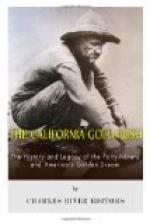Though this attempt at home to gain coherence failed, the partisans at Sacramento had better luck. They collected, it was said, five hundred men hailing from all quarters of the globe, but chiefly from the Southeast and Texas. All of them were fire-eaters, reckless, and sure to make trouble. Two pieces of artillery were reported coming down the Sacramento to aid all prisoners, but especially Billy Mulligan. The numbers were not in themselves formidable as opposed to the enrollment of the Vigilance Committee, but it must be remembered that the city was full of scattered warriors and of cowed members of the underworld waiting only leaders and a rallying point. Even were the Vigilantes to win in the long run, the material for a very pretty civil war was ready to hand. Two hundred men were hastily put to filling gunnybags with sand and to fortifying not only headquarters but the streets round about. Cannon were mounted, breastworks were piled, and embrasures were cut. By morning Fort Gunnybags, as headquarters was henceforth called, had come into existence.
The fire-eaters arrived that night, but they were not five hundred strong, as excited rumor had it. They disembarked, greeting the horde of friends who had come to meet them, marched in a body to Fort Gunnybags, looked it over, stuck their hands into their pockets, and walked peacefully away to the nearest bar-rooms. This was the wisest move on their part, for by now the disposition of the Vigilante men was so complete that nothing short of regularly organized troops could successfully have dislodged them.
Behind headquarters was a long shed and stable In which were to be found at all hours saddle horses and artillery horses, saddled and bridled, ready for instant use. Twenty-six pieces of artillery, most of them sent in by captains of vessels in the harbor, were here parked. Other cannon were mounted for the defense of the fort itself. Muskets, rifles, and sabers had been accumulated. A portable barricade had been constructed in the event of possible street fighting—a sort of wheeled framework that could be transformed into litters or scaling-ladders at will. Mess offices and kitchens were there that could feed a small army. Flags and painted signs carrying the open eye that had been adopted as emblematic of vigilance decorated the main room. A huge alarm bell had been mounted upon the roof. Mattresses, beds, cots, and other furniture necessary to accommodate whole companies on the premises themselves, had been provided. A completely equipped armorers’ shop and a hospital with all supplies occupied the third story. The forces were divided into four companies of artillery, one squadron and two troops of cavalry, four regiments and thirty-two companies of infantry, besides the small but very efficient police organization. A tap on the bell gathered these men in an incredibly short space of time. Bancroft says that, as a rule, within fifteen minutes of the first stroke seven-tenths of the entire forces would be on hand ready for combat.




